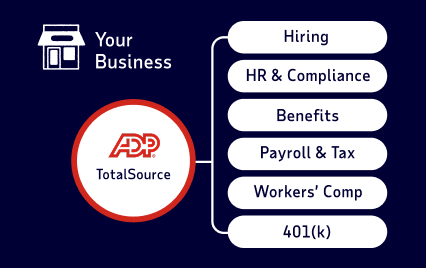FAQ
What is co-employment? How it works and benefits
See the HR support you can get when you work with the nation's largest PEO.
Co-employment is a contractual relationship, in which a business and a professional employer organization (PEO) share certain employment responsibilities. This arrangement is advantageous to organizations that want to mitigate some of the costs and liability associated with being an employer. Outsourcing with a co-employer also allows owners and executive leaders to focus more of their efforts on growing their business and less on HR.
Table of Contents
How does co-employment work?
Despite some misconceptions, co-employment does not mean employers cede ownership or lose control of their business. In actuality, clients continue to manage their employees and day-to-day operations, while the PEO focuses on HR-related tasks, such as payroll, benefits administration and regulatory compliance.
Explore Learn more about the benefits of ADP's PEO
What are the benefits of a co-employment relationship?
High-quality, forward-thinking PEOs like ADP’s use data insights, evolving technology and skilled advisors to help clients respond strategically to regulatory changes and workforce trends, thereby allowing them to remain competitive and maximize growth. Other benefits of co-employment include:
Access to Fortune 500®-caliber benefits
One of the main reasons small and midsized businesses enter into co-employment arrangements is the high-quality, cost-effective health insurance that it affords them. In addition to supplying the coverage, PEOs typically manage enrollment, claims and other aspects of plan administration. Some even offer benefits beyond medical and dental insurance, like retirement savings plans, education reimbursement, commuter benefits and more.
Full-service payroll
Employers who are struggling to find time to run payroll or are being penalized for mistakes often find welcomed respite in co-employment. PEOs may administer aspects of payroll on the client’s behalf, including calculating wages and deductions, paying employees, and filing employment taxes with government agencies. Many are also capable of integrating payroll with timekeeping and insurance services, which limits repetitive data entry and reduces errors.
Compliance expertise
Compliance may seem like a daunting challenge, but co-employment can provide peace of mind, especially for businesses that aren’t prepared to handle regulatory oversights. PEOs have risk and compliance experts who keep up with evolving HR regulations and work with clients to develop proactive strategies that can help protect them from fines and penalties. Areas of focus include tax reporting, unemployment and workers’ compensation claims, and workplace policies.
Workers’ compensation coverage
Meeting state requirements for workers’ compensation insurance is one less headache for businesses in co-employment arrangements. PEOs provide coverage for their clients and handle any claims that may arise. They also can conduct safety audits and recommend employee training programs to help limit workplace injuries and employer liability.
HR support
Businesses that don’t have or want to hire dedicated internal resources for HR can rely on a PEO for their HR needs. In co-employment arrangements, clients may have a dedicated HR expert or team, depending on the level of support required, that provides strategic and administrative services. If, on the other hand, employers have their own resources, they can continue to use them and may partner with the PEO whenever additional expertise or assistance is necessary.
Talent management strategy
The benefit packages that come with co-employment can help businesses appear more attractive to prospective talent, but that’s just the beginning. PEOs will often assist with onboarding, employee training and performance management. Some also provide strategic services that can help employers adapt to changing workplace demographics and the increasing prevalence of contract and short-term workers.

ADP’s PEO: Your business’s competitive edge
ADP TotalSource®, our PEO, offers a cost-effective HR solution that handles benefits, payroll, tax support, workers' compensation, and hiring, so you can get back to business.
Are there potential risks to co-employment?
Working in a co-employment relationship with a PEO is low risk, especially if the PEO is certified by the IRS and accredited by the Employer Services Assurance Corporation (ESAC). If businesses work with a PEO that does not have these credentials or a track record of ethical business practices, it could expose them to the following:
- Wage-base restart: If a business joins or leaves a co-employment arrangement midyear, it may be subject to a wage-base restart for certain payroll taxes.
- Tax liability: If a PEO is not certified by the IRS and fails to pay taxes on behalf of a client, the client can be held responsible and penalized, even if the business already paid the money for the taxes to the PEO as part of the service contract.
How can you avoid co-employment risks?
Employers can avoid co-employment risks by partnering with PEOs that meet the rigorous background, financial and reporting requirements necessary for certification with the IRS and the Employer Services Assurance Corporation (ESAC). Certified PEOs (CPEOs) offer these advantages:
- CPEOs are solely responsible for the payment of their client’s federal employment taxes
- Businesses can join or leave a CPEO at any time of the year without facing a wage-base tax restart
- CPEO clients can continue to claim any tax credits for which they would normally be eligible if they were not in a co-employment arrangement

Double-certified for your peace of mind
Few PEOs are certified by the ESAC and IRS. So, you can rest easy knowing your business is in good hands with ADP.
What is not co-employment?
Co-employment is sometimes mistaken for employee leasing and joint employment, but they are not one and the same. The key distinction between them lies in how the employer responsibilities are allocated.
What does employee leasing mean?
Employee leasing is an arrangement where a staffing firm provides a business with employees for a temporary assignment and when it’s completed, they return to the agency. Co-employment is different because PEOs don’t supplement a client’s workforce with additional labor and should the relationship between the PEO and the employer end, the employees remain with the client.
What does joint employment mean?
Joint employment means that two distinct employers govern the same employees. In a typical example, both parties would have input on employee supervision, wages, schedules, performance and disciplinary action or termination. With co-employment, on the other hand, only the client business, not the PEO, manages hiring decisions and the daily activities of the workforce.
Is co-employment the same as joint employment?
Co-employment and joint employment are not the same, largely because of workforce management. In a co-employment arrangement, the client company remains responsible for their employees’ job duties and day-to-day activities, while the co-employer handles the HR administrative tasks outlined in the services agreement. In a joint employment relationship, both parties have input on wages, hours, schedules, hiring decisions, terminations, etc.
| Co-employment | Joint employment | |
|---|---|---|
| Control |
|
|
| Liability |
|
|
| Tax implications |
|
|
| Worker classification |
|
|
Why choose ADP for co-employment?
ADP TotalSource® is the largest PEO in the United States and has proven expertise in all areas of human resources. Our products and services are designed to help businesses adapt to changing workplace trends and improve their bottom line. Some of the strategic solutions that sets TotalSource apart from the competition include:
- Data insights and reports
While some PEOs offer limited data, TotalSource provides benchmark analytics that allow employers to see how their business compares to others in their industry. - Custom success plans
TotalSource is the only PEO that develops personalized HR plans covering benefits, risk and talent optimization that align with a business’s strategy and growth objectives. - Protection
ADP helps its clients limit their liability by providing guidance on workplace safety, interviews, terminations, employee discipline and mandatory leave laws. In some cases, we can also assist with employee lawsuits. - Strategic talent management
TotalSource goes beyond basic recruitment technology and provides full talent support, including performance management, compensation analysis, supply and demand reports, and engagement and coaching strategy.
Explore See how ADP TotalSource® helps you do more
Frequently asked questions about co-employment
What is a PEO relationship?
PEOs serve as the employer of record for a business for tax purposes. This type of relationship also helps employers manage payroll, HR, benefits, workers’ compensation and regulatory compliance so they have more time to pursue other business goals.
What is a co-employment agreement?
A co-employment agreement is a legal and contractual arrangement in which a PEO and a client company share employment responsibilities. This partnership enables the PEO to manage HR functions, such as payroll, benefits and compliance with labor laws while the client company retains control over day-to-day operations and direct employee supervision. This structure helps the client navigate complex employment regulations and reduce administrative burdens, ensuring a more efficient and compliant workforce management system.
Is co-employment illegal?
Co-employment is legal. In fact, the IRS supports the PEO community with a certification process that helps businesses find a PEO that meets its strict standards. Business owners who want the utmost reliability and security often partner with an IRS-certified CPEO.2
Ready to get started with a PEO?
Partnering with ADP’s award-winning PEO means you get access to top-tier benefits and a personalized service experience that stands above the rest.
Want more exclusive business insights like this delivered to your inbox?Subscribe now
2. The IRS does not endorse any particular certified professional employer organization. For more information on certified professional employer organizations, go to https://www.irs.gov/





